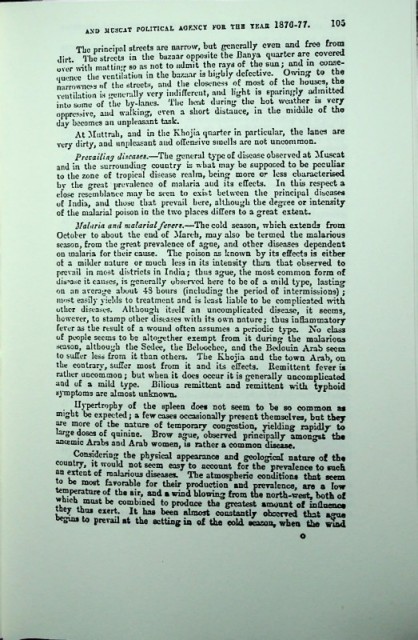Page 353 - PERSIAN GULF ADMINISTRATION REPORTS V1
P. 353
AND MUSCAT POLITICAL AGENCY IOE THE YEAR 1870-77. 105
The principal streets are narrow, but generally even and free from
The streets in the bazaar opposite the Banya quarter are covered
dirt.
over
quence
narrowness of the streets, and the closeness of most of the houses, the
ventilation is -onorally very indifferent, and light is sparingly admitted
into some of the by-lanes. The heat during the hot weather is very
oppressive, and walking, even a short distance, in the middle of the
day becomes an unpleasant task.
At Muttrah, and in the Khojia quarter in particular, the lanes are
vcry dirty, and unpleasant and offensive smells arc not uncommon.
Prevailin'/ diseases.—The general type of disease observed at Muscat
and in the surrounding country is what may be supposed to be peculiar
to the zone of tropical disease realm, being more or less characterised
bv the great prevalence of malaria aud its effects. In this respect a
close resemblance may be seen to exist between the principal diseases
of India, and those that prevail here, although the degree or intensity
of the malarial poison in the two places differs to a great extent.
ifalaria and malarial fevers.—The cold season, which extends from
October to about the end of March, may also be termed the malarious
season, from the great prevalence of ague, and other diseases dependent
on malaria for their cause. The poison as known by its effects is either
ot a milder nature or much less in its intensity than that observed to
prevail in most districts in India; thus ague, the most common form of
disease it causes, is generally observed here to be of a mild type, lasting
on an average about 43 hours (including the period of intermissions) ;
most easily yields to treatment and is least liable to be complicated with
other diseases. Although itself an uncomplicated disease, it seems,
however, to stamp other diseases with its own nature; thus inflammatory
fever as the result of a wound often assumes a periodic type. No class
of people seems to be altogether exempt from it during the malarious
season, although the Sedee, the Belooehee, and the Bedouin Arab seem
to suffer less from it than others. The Khojia and the town Arab, on
the contrary, suffer most from it and its effects. Remittent fever is
rather uncommon ; but when it does occur it is generally uncomplicated
and of a mild type. Bilious remittent and remittent with typhoid
symptoms are almost unknown.
Hypertrophy of the spleen does not seem to be so common as
might be expected; a few cases occasionally present themselves, but they
are more of the nature of temporary congestion, yielding rapidly to
large doses of quinine. Brow ague, observed principally amon<*st the
ancemic Arabs and Arab women, is rather a common disease. °
Considering the physical appearance and geological nature of the
countpr, it would not seem easy to account for the prevalence to 6uch
an extent of malarious diseases. The atmospheric conditions that seem
to be most favorable for their production and prevalence, are a low
temperature of the air, and a wind blowing from the north-west, both of
wnich most be combined to produce the greatest amount of influence
ney thus exert. It has been almost constantly observed that *<*ue
to prevail at the setting in of the cold season, when the wind
o

